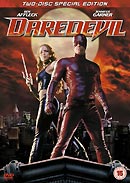 |
DAREDEVIL
Director:
Mark Steven Johnson
Starring:
Ben Affleck, Jennifer Garner, Colin Farrell, Michael Clarke Duncan
NB: This review includes minor spoilers.
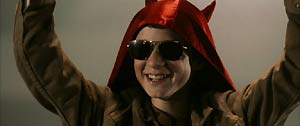 Although clearly
formed from the same mould as Tim Burton's Batman, Mark Steven
Johnson's adaptation of Marvel Comics' Daredevil is arguably the
most successful attempt so far at capturing the spirit and form of a comic
strip. The film is light on plot, but packs in the action, and features
stunt work that, frankly, embarrasses it's recent stable-mate, Sam Raimi's
2002 adaptation of Spider-Man. Although clearly
formed from the same mould as Tim Burton's Batman, Mark Steven
Johnson's adaptation of Marvel Comics' Daredevil is arguably the
most successful attempt so far at capturing the spirit and form of a comic
strip. The film is light on plot, but packs in the action, and features
stunt work that, frankly, embarrasses it's recent stable-mate, Sam Raimi's
2002 adaptation of Spider-Man.
Daredevil,
the story of Matt Murdock, a man who's become a lawyer by day, and super
hero vigilante by night, after a childhood accident left him blinded, is a
pulpy action movie populated by broadly-drawn characters motivated by
their most primal instincts. Most of the film takes place in the grungy
world inhabited by our hero: a man who doesn't need light to be able to
see, thanks to his finely-developed senses. The film pits Daredevil
against the evil crime lord Kingpin (The Green Mile's Michael
Clarke Duncan) and his hired hit-man Bullseye (Phone Booth's Colin
Farrell). It also matches him against the feisty assassin Elektra (Alias
star Jennifer Garner), who is, conveniently, unaware that she's dating
Daredevil's daytime alter ego.
The UK Region 2 DVD
features the uncut version of the film, despite carrying the same rating -
15 - as the theatrical release, which was censored by the BBFC. Changes
made to the UK theatrical release - to remove a scene where one of
Elektra's sai's penetrates someone's palm, and to tone down a scene in the
finale where the villain's legs are broken (the crack was buried under a
handy rumble of thunder) - have been restored for the DVD.
The film seems more or
less evenly divided between scenes that take place in bright daylight,
which translate very nicely to DVD, and those that take place in
near-darkness, which are more problematic. Fox's DVD transfer makes a good
job of taming both, but the film's Super 35 cinematography, (which was
extensively adjusted digitally in post-production), isn't its strongest
asset, and to get the best out of the disc you'll need to watch the film
in complete darkness.
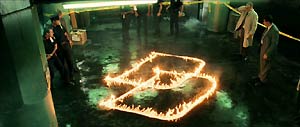 The
disc presents the film in anamorphic widescreen format, with a ratio of
about 2.35:1. Much of the film uses a deliberately subdued, urban palette.
This drab backdrop enables the filmmakers to make startling use of
splashes of vivid colour that pepper the film, (the use of red throughout
the film is carefully controlled, for example). Viewers who haven't seen
the film may be surprised that there aren't any sequences in the film
where they'll get as good a look at Murdock's Daredevil costume (designed
by multi-Oscar and BAFTA-award winner James Acheson, who also worked on Spider-Man)
as they do on the various posters, or on the box of the DVD. In fact, as
Mark Steven Johnson explains on the disc's commentary track, studio
executives were so paranoid that Daredevil would look stupid
that in many sequences you'd be hard pressed to tell that the costume is
red at all: it was deliberately shot to appear almost black (picking up
the lead set by The X-Men movie). Fox's disc is unlikely to win any
prizes for its transfer, which is as good as you'd expect from a
big-budget blockbuster, but not especially outstanding. Black levels are
solid and contrast is excellent. The picture can be rather soft, though, and there's rarely much
"bite" to the image. Average bitrate is a healthy 7.35Mb/sec. The
disc presents the film in anamorphic widescreen format, with a ratio of
about 2.35:1. Much of the film uses a deliberately subdued, urban palette.
This drab backdrop enables the filmmakers to make startling use of
splashes of vivid colour that pepper the film, (the use of red throughout
the film is carefully controlled, for example). Viewers who haven't seen
the film may be surprised that there aren't any sequences in the film
where they'll get as good a look at Murdock's Daredevil costume (designed
by multi-Oscar and BAFTA-award winner James Acheson, who also worked on Spider-Man)
as they do on the various posters, or on the box of the DVD. In fact, as
Mark Steven Johnson explains on the disc's commentary track, studio
executives were so paranoid that Daredevil would look stupid
that in many sequences you'd be hard pressed to tell that the costume is
red at all: it was deliberately shot to appear almost black (picking up
the lead set by The X-Men movie). Fox's disc is unlikely to win any
prizes for its transfer, which is as good as you'd expect from a
big-budget blockbuster, but not especially outstanding. Black levels are
solid and contrast is excellent. The picture can be rather soft, though, and there's rarely much
"bite" to the image. Average bitrate is a healthy 7.35Mb/sec.
The film's sound mix,
on the other hand, is simply stunning, The disc offers a choice of Dolby
Digital 5.1 (at 448kbps) and DTS (at 768kbps) tracks. Both are thrilling,
but the DTS has the edge, with more vivid presence. The mix is dynamic and
elaborate, with plenty of action pushed into the rear channels. The mix
also gives flight to the film's songs (some of which actually seem to
belong in the film, and not simply wedged in by marketing considerations)
and to Graeme Revell's ballsy orchestral score. Fox has commendably
provided a narrated (2.0) audio track on the feature for the visually
impaired. The film and most (if not all) of the bonus materials offer
English subtitles.
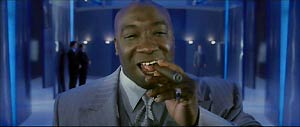 Disc
one offers an option to watch the film in Enhanced Mode, which offers
eight short behind the scenes sequences, slotted into the film where
appropriate. These range from less than a minute long, to a Grab Bag
of bits and pieces running for almost eight minutes (including material
about the film's deleted "Frogger"-like sequence, and costume
and model tests). Most of these sequences offers a choice of three
angles. The first angle is the animatic version of the scene, the second
is the raw effects footage, and the third is both side by side. It's
easiest to orientate yourself by watch the third angle first, and then
examine the two components in full-screen. Each clip has commentary by
Visual Effects Producer John Kilkenny. All this material is offered in
anamorphic widescreen format. The US disc presents these cutaways with a
White Rabbit-style icon option, but, as with the Region 2
X-Men
1.5 disc, the UK version does some of the work for you once the
Enhanced Mode option has been selected. Six of one... Watching each
segment twice or three times is a bit of a pain. More than once I managed
to crash out of the disc by trying to rewind back to the entry point,
meaning I had to sit through the disc's tedious opening sequence
(copyright warning, trailers to be skipped and animated menus) again. It
would have been far more sensible to edit each of these segments into a single
sequence, (which would also have offered the benefit of a less hurried
commentary). Sometimes more is less. Disc
one offers an option to watch the film in Enhanced Mode, which offers
eight short behind the scenes sequences, slotted into the film where
appropriate. These range from less than a minute long, to a Grab Bag
of bits and pieces running for almost eight minutes (including material
about the film's deleted "Frogger"-like sequence, and costume
and model tests). Most of these sequences offers a choice of three
angles. The first angle is the animatic version of the scene, the second
is the raw effects footage, and the third is both side by side. It's
easiest to orientate yourself by watch the third angle first, and then
examine the two components in full-screen. Each clip has commentary by
Visual Effects Producer John Kilkenny. All this material is offered in
anamorphic widescreen format. The US disc presents these cutaways with a
White Rabbit-style icon option, but, as with the Region 2
X-Men
1.5 disc, the UK version does some of the work for you once the
Enhanced Mode option has been selected. Six of one... Watching each
segment twice or three times is a bit of a pain. More than once I managed
to crash out of the disc by trying to rewind back to the entry point,
meaning I had to sit through the disc's tedious opening sequence
(copyright warning, trailers to be skipped and animated menus) again. It
would have been far more sensible to edit each of these segments into a single
sequence, (which would also have offered the benefit of a less hurried
commentary). Sometimes more is less.
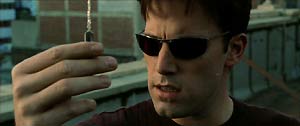 The
film is also accompanied by a text commentary, which notes trivia like
cameo appearances, and which characters are named after Daredevil comic
book writers and artists. There's a fair bit of crossover between this and
the audio commentary, so it's best to have both on together. The audio
commentary, by Mark Steven Johnson and producer Gary Foster is full of
interesting information, and is often remarkably candid. There are nice
stories about Colin Farrell, who seems like a bit of a handful, a few
well-deserved digs at Spider-Man, and, equally, plenty of
self-deprecation about a few Daredevil FX shots that don't work.
You'll also learn about a sequence that was radically re-structured
(transforming
a man who beats his son into a street mugger), discover which sequence of
the film was "inspired by" a Visa commercial, and find out which
key scene was added long after principal photography was completed
(guess!) The
film is also accompanied by a text commentary, which notes trivia like
cameo appearances, and which characters are named after Daredevil comic
book writers and artists. There's a fair bit of crossover between this and
the audio commentary, so it's best to have both on together. The audio
commentary, by Mark Steven Johnson and producer Gary Foster is full of
interesting information, and is often remarkably candid. There are nice
stories about Colin Farrell, who seems like a bit of a handful, a few
well-deserved digs at Spider-Man, and, equally, plenty of
self-deprecation about a few Daredevil FX shots that don't work.
You'll also learn about a sequence that was radically re-structured
(transforming
a man who beats his son into a street mugger), discover which sequence of
the film was "inspired by" a Visa commercial, and find out which
key scene was added long after principal photography was completed
(guess!)
The movie disc opens
with trailers for Solaris, Phone Booth, X-Men 2, The
League of Extraordinary Gentlemen, Master and Commander and Bulletproof
Monk. These can be fast-forwarded through, or skipped entirely using
the Menu option.
The second disc is
also a DVD-9 (dual-layer) disc. Fox is, without doubt, the most
adventurous studio when it comes to DVD. They've issued a string of
special edition discs which make the best offerings from their rivals look
positively miserly. Daredevil easily rivals some of the studio's
past DVD triumphs, like their outstanding two-disc editions of Fight
Club and Tim Burton's Planet of the Apes. It's also worth
noting that Fox is also the only company that regularly makes extensive
use of the format's capabilities (branching, multi-angles, etc) for
supplementary material.
The second disc is
divided into two parts, devoted to The Film and The Comic Book.
The Film:
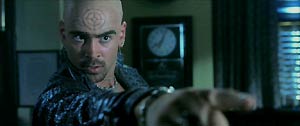 At
the heart of the second disc is Beyond Hell's Kitchen: Making Daredevil,
a reasonably comprehensive look at the film's production, running
just under an hour. It skims over the film's initial development, which
began at Fox in 1997 (when the director of the first two Harry Potter
movies, Chris Columbus, was earmarked to direct), moved to Disney in 1998,
as Marvel teetered on the edge of bankruptcy, and then to Sony
(Columbia) in 1999, before finally returning to Fox as a production made
by New Regency. The documentary features contributions from most of the
film's key contributors, including plenty of candid footage of the lead
actors ("Oh - I got you right in the nuts!") Most aspects of the
production are covered, including a look at the stunt work, and the often
frustrating process of creating the film's music. The ratio of behind the
scenes material to talking heads is high, and that makes it significantly
more interesting than many similar documentaries. At
the heart of the second disc is Beyond Hell's Kitchen: Making Daredevil,
a reasonably comprehensive look at the film's production, running
just under an hour. It skims over the film's initial development, which
began at Fox in 1997 (when the director of the first two Harry Potter
movies, Chris Columbus, was earmarked to direct), moved to Disney in 1998,
as Marvel teetered on the edge of bankruptcy, and then to Sony
(Columbia) in 1999, before finally returning to Fox as a production made
by New Regency. The documentary features contributions from most of the
film's key contributors, including plenty of candid footage of the lead
actors ("Oh - I got you right in the nuts!") Most aspects of the
production are covered, including a look at the stunt work, and the often
frustrating process of creating the film's music. The ratio of behind the
scenes material to talking heads is high, and that makes it significantly
more interesting than many similar documentaries.
The
documentary, like the film itself, is also offered with enhanced viewing mode, which adds half a dozen extra
segments, which add about twenty minutes or so to the documentary's
running time. The six cutaways are effectively mini-featurettes. Unlike the ones in the film,
these can
be accessed separately. These featurettes each focus on one specific
aspect of the film: on Costume
Design (where you'll see an array of rejected test costumes, including
ones with a bandana-style mask, and a boxer's gown-style hood); L.A.
for N.Y. (a look at how the filmmakers made Los Angeles (where most of
the film was shot) look like New York (where it's set)); Combat
Choreography (concept footage of the playground and church fights); Smoke
and Fire (showing examples of the film's practical effects, including
Bullseye's darts gag, which was eventually re-done with CGI); Film Work (an
explanation of how the film is handled during production, with Matthew
Schmidt, the assistant editor, who notes that Daredevil generated about
half a million feet of film - about half what might be expected for a movie
of this type); and Seeing With Sound (focusing on the design and development
of Matt Murdock's sonar-like "Shadow World" visualisations).
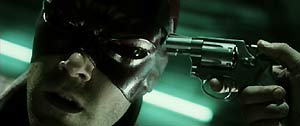 When
you watch the extended Beyond Hell's Kitchen documentary, note that
this features behind the scenes footage of the original version of a line
spoken by Bullseye in Wilson Fisk's office. The line was changed in the
film to "I want a bloody costume" at the insistence of the MPAA).
The documentary includes the original line, and not just once, but
twice! Take that, MPAA! It's worth noting that the commentary and the
documentary both contain numerous examples of strong language. There's
more off-colour shenanigans in the Blooper Reel, which is hidden as
an Easter Egg on the Beyond Hell's Kitchen: Making Daredevil menu.
This six-minute selection includes some choice material, including Jon
Favreau ad-libbing, Jennifer Garner getting the giggles, and some nice
shots of Affleck and Garner doing back-flips on the see-saws. When
you watch the extended Beyond Hell's Kitchen documentary, note that
this features behind the scenes footage of the original version of a line
spoken by Bullseye in Wilson Fisk's office. The line was changed in the
film to "I want a bloody costume" at the insistence of the MPAA).
The documentary includes the original line, and not just once, but
twice! Take that, MPAA! It's worth noting that the commentary and the
documentary both contain numerous examples of strong language. There's
more off-colour shenanigans in the Blooper Reel, which is hidden as
an Easter Egg on the Beyond Hell's Kitchen: Making Daredevil menu.
This six-minute selection includes some choice material, including Jon
Favreau ad-libbing, Jennifer Garner getting the giggles, and some nice
shots of Affleck and Garner doing back-flips on the see-saws.
The second disc also
includes the HBO First Look special (25m), presented by Jennifer
Garner (it's on-screen title is Daredevil: From The Comic To The Big
Screen). This is a relatively elaborate promotional documentary: no
less superficial then usual, but offering more sound-bites from the cast
and key crew members, and more behind-the-scenes footage. There's a bit of
duplication between this and the Beyond Hell's Kitchen documentary,
but both are worth watching. This documentary is presented in 4:3 ratio,
and eagle-eyed viewers might notice that some of the clips used are
presented differently to the versions in the film.
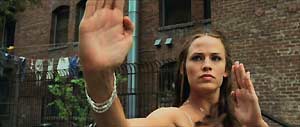 Other
bonus materials on the second disc include: Jennifer Garner's Screen Test (3m, which
includes dialogue dropped from the playground fight scene, about her
bodyguards); Multi-Angles Dailies (a chance to examine the raw
footage of a brief part of the Daredevil / Kingpin fight (one take, three
angles) and the Bullseye / Elektra fight (three separate takes, up to four
angles); Featured Villain Kingpin (a very short interview with
Michael Clarke Duncan); Moving Through Space: A Day With Tom Sullivan (8m,
a featurette exploring the life of the film's blind consultant, which includes a tale about how Sullivan once won
a wrestling match by popping out one of his artificial eyes!) Other
bonus materials on the second disc include: Jennifer Garner's Screen Test (3m, which
includes dialogue dropped from the playground fight scene, about her
bodyguards); Multi-Angles Dailies (a chance to examine the raw
footage of a brief part of the Daredevil / Kingpin fight (one take, three
angles) and the Bullseye / Elektra fight (three separate takes, up to four
angles); Featured Villain Kingpin (a very short interview with
Michael Clarke Duncan); Moving Through Space: A Day With Tom Sullivan (8m,
a featurette exploring the life of the film's blind consultant, which includes a tale about how Sullivan once won
a wrestling match by popping out one of his artificial eyes!)
The disc
also contains three theatrical trailers (including the teaser trailer,
which contains a shot of murder suspect Daunte Jackson, (played by
Coolio, whose scenes were dropped from the finished film), and three music
videos in 2.0 stereo: Fuel's Won't Back Down, The Calling's For
You and Evenescence's Bring Me to Life (the track used during
Elektra's training montage). Comprehensive image galleries offer the
film's terrific comic-strip-style storyboards, production art and a rather
skimpy selection of photographs (no great loss: the on-set photographs
from the film were mediocre). These aren't terribly well presented (the
framing is ugly and too much space is wasted by the border). One
section, labeled Production Stills actually contains more artwork. The
galleries contain about five hundred images.
A promotional advert
for the soundtrack CD, a trailer for
28
Days Later and some insignificant DVD-ROM materials seem to be the
only things that are on the US disc, but aren't on the UK version.
Although there's a lot of talk on the
commentary track about material that was shot and discarded, most of it
refers to alternate versions of scenes which did make it into the film. It
doesn't sound like any major plot strands were abandoned, and it doesn't
sound like there'd be much to add back in to the film if there were ever
to be a Director's Cut version somewhere down the line (perhaps to
coincide with the theatrical release of the inevitable sequel, as Fox did
with X-Men 1.5). Nevertheless, the absence
of deleted scenes is disappointing.
The Comic Book:
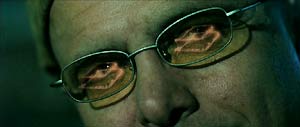 I've
never been a vociferous comic book reader, and don't remember being
exposed to the Daredevil character before, other than fleetingly admiring
some of the cover art. I knew that the film had made a few rather drastic
changes to the comic book characters, (Kingpin, who is depicted as
being a sumo-wrestler sized white guy in the comics, is now a
6-foot-7-inch tall black dude, for example), but other than that I had no
handle on the character's history. The hour-long
documentary The Men Without Fear: Creating Daredevil is a
terrific potted history of the character,which will bring the uninitiated
up to speed. The story of the Daredevil comic book is told by the artists and writers
who have worked on the strip since it made its debut in 1964. Men
Without Fear includes interviews with creator Stan "The Man"
Lee, veterans like John Romita and Gene Colan, and relative
newcomers like Frank Miller (who created Elektra, re-invented Kingpin, and
is generally credited with completely revitalising the character in the
early 80s). Each explains how they're built on the foundations laid down
by their predecessors, and how their own contribution has shaped the
character's destiny. It's perhaps unlikely that Daredevil's
stalwart fans will learn very much, but they will probably be thrilled to
hear these guys speak. I've
never been a vociferous comic book reader, and don't remember being
exposed to the Daredevil character before, other than fleetingly admiring
some of the cover art. I knew that the film had made a few rather drastic
changes to the comic book characters, (Kingpin, who is depicted as
being a sumo-wrestler sized white guy in the comics, is now a
6-foot-7-inch tall black dude, for example), but other than that I had no
handle on the character's history. The hour-long
documentary The Men Without Fear: Creating Daredevil is a
terrific potted history of the character,which will bring the uninitiated
up to speed. The story of the Daredevil comic book is told by the artists and writers
who have worked on the strip since it made its debut in 1964. Men
Without Fear includes interviews with creator Stan "The Man"
Lee, veterans like John Romita and Gene Colan, and relative
newcomers like Frank Miller (who created Elektra, re-invented Kingpin, and
is generally credited with completely revitalising the character in the
early 80s). Each explains how they're built on the foundations laid down
by their predecessors, and how their own contribution has shaped the
character's destiny. It's perhaps unlikely that Daredevil's
stalwart fans will learn very much, but they will probably be thrilled to
hear these guys speak.
As with most film adaptations from long-running
comic strips, the Daredevil movie steals extensively from the best
material generated over the years and attempts to condense it into a cohesive single
story. The Men Without Fear documentary doesn't really explain this process, but
viewers will be able to see how the main characters in the
movie were developed, and even where some of the specific plot ideas
originated.
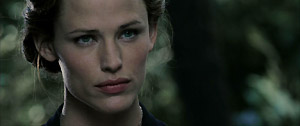 Disc
two's other two bonus features are a disappointment after viewing the rest
of the material, so I'd recommend saving something else until last (the Blooper
Reel, perhaps?). Shadow World Tour (6m) compares panels
from the comic strip with to the same concepts as they're portrayed in the
film. It's clumsily constructed, though, and could have been better presented it in the same way that storyboards
usually are: side by side with the equivalent shots in the movie. Disc
two's other two bonus features are a disappointment after viewing the rest
of the material, so I'd recommend saving something else until last (the Blooper
Reel, perhaps?). Shadow World Tour (6m) compares panels
from the comic strip with to the same concepts as they're portrayed in the
film. It's clumsily constructed, though, and could have been better presented it in the same way that storyboards
usually are: side by side with the equivalent shots in the movie.
Modelling Sheets are
bullet-point profiles of the five main characters (including Franklin "Foggy" Nelson, Matt
Murdock's law partner, who is played in the film by Jon Favreau). These
were taken from the Marvel
Encyclopedia .
Fox has,
once again, delivered almost everything any reasonable person could want
from a DVD, and more than a few goodies than we have a right to expect
(the DTS track, for example).
RELATED REVIEWS:
Daredevil:
Director's Cut
Elektra |



 Although clearly
formed from the same mould as Tim Burton's Batman, Mark Steven
Johnson's adaptation of Marvel Comics' Daredevil is arguably the
most successful attempt so far at capturing the spirit and form of a comic
strip. The film is light on plot, but packs in the action, and features
stunt work that, frankly, embarrasses it's recent stable-mate, Sam Raimi's
2002 adaptation of Spider-Man.
Although clearly
formed from the same mould as Tim Burton's Batman, Mark Steven
Johnson's adaptation of Marvel Comics' Daredevil is arguably the
most successful attempt so far at capturing the spirit and form of a comic
strip. The film is light on plot, but packs in the action, and features
stunt work that, frankly, embarrasses it's recent stable-mate, Sam Raimi's
2002 adaptation of Spider-Man. The
disc presents the film in anamorphic widescreen format, with a ratio of
about 2.35:1. Much of the film uses a deliberately subdued, urban palette.
This drab backdrop enables the filmmakers to make startling use of
splashes of vivid colour that pepper the film, (the use of red throughout
the film is carefully controlled, for example). Viewers who haven't seen
the film may be surprised that there aren't any sequences in the film
where they'll get as good a look at Murdock's Daredevil costume (designed
by multi-Oscar and BAFTA-award winner James Acheson, who also worked on Spider-Man)
as they do on the various posters, or on the box of the DVD. In fact, as
Mark Steven Johnson explains on the disc's commentary track, studio
executives were so paranoid that Daredevil would look stupid
that in many sequences you'd be hard pressed to tell that the costume is
red at all: it was deliberately shot to appear almost black (picking up
the lead set by The X-Men movie). Fox's disc is unlikely to win any
prizes for its transfer, which is as good as you'd expect from a
big-budget blockbuster, but not especially outstanding. Black levels are
solid and contrast is excellent. The picture can be rather soft, though, and there's rarely much
"bite" to the image. Average bitrate is a healthy 7.35Mb/sec.
The
disc presents the film in anamorphic widescreen format, with a ratio of
about 2.35:1. Much of the film uses a deliberately subdued, urban palette.
This drab backdrop enables the filmmakers to make startling use of
splashes of vivid colour that pepper the film, (the use of red throughout
the film is carefully controlled, for example). Viewers who haven't seen
the film may be surprised that there aren't any sequences in the film
where they'll get as good a look at Murdock's Daredevil costume (designed
by multi-Oscar and BAFTA-award winner James Acheson, who also worked on Spider-Man)
as they do on the various posters, or on the box of the DVD. In fact, as
Mark Steven Johnson explains on the disc's commentary track, studio
executives were so paranoid that Daredevil would look stupid
that in many sequences you'd be hard pressed to tell that the costume is
red at all: it was deliberately shot to appear almost black (picking up
the lead set by The X-Men movie). Fox's disc is unlikely to win any
prizes for its transfer, which is as good as you'd expect from a
big-budget blockbuster, but not especially outstanding. Black levels are
solid and contrast is excellent. The picture can be rather soft, though, and there's rarely much
"bite" to the image. Average bitrate is a healthy 7.35Mb/sec. Disc
one offers an option to watch the film in Enhanced Mode, which offers
eight short behind the scenes sequences, slotted into the film where
appropriate. These range from less than a minute long, to a Grab Bag
of bits and pieces running for almost eight minutes (including material
about the film's deleted "Frogger"-like sequence, and costume
and model tests). Most of these sequences offers a choice of three
angles. The first angle is the animatic version of the scene, the second
is the raw effects footage, and the third is both side by side. It's
easiest to orientate yourself by watch the third angle first, and then
examine the two components in full-screen. Each clip has commentary by
Visual Effects Producer John Kilkenny. All this material is offered in
anamorphic widescreen format. The US disc presents these cutaways with a
White Rabbit-style icon option, but, as with the Region 2
Disc
one offers an option to watch the film in Enhanced Mode, which offers
eight short behind the scenes sequences, slotted into the film where
appropriate. These range from less than a minute long, to a Grab Bag
of bits and pieces running for almost eight minutes (including material
about the film's deleted "Frogger"-like sequence, and costume
and model tests). Most of these sequences offers a choice of three
angles. The first angle is the animatic version of the scene, the second
is the raw effects footage, and the third is both side by side. It's
easiest to orientate yourself by watch the third angle first, and then
examine the two components in full-screen. Each clip has commentary by
Visual Effects Producer John Kilkenny. All this material is offered in
anamorphic widescreen format. The US disc presents these cutaways with a
White Rabbit-style icon option, but, as with the Region 2
 The
film is also accompanied by a text commentary, which notes trivia like
cameo appearances, and which characters are named after Daredevil comic
book writers and artists. There's a fair bit of crossover between this and
the audio commentary, so it's best to have both on together. The audio
commentary, by Mark Steven Johnson and producer Gary Foster is full of
interesting information, and is often remarkably candid. There are nice
stories about Colin Farrell, who seems like a bit of a handful, a few
well-deserved digs at Spider-Man, and, equally, plenty of
self-deprecation about a few Daredevil FX shots that don't work.
You'll also learn about a sequence that was radically re-structured
(transforming
a man who beats his son into a street mugger), discover which sequence of
the film was "inspired by" a Visa commercial, and find out which
key scene was added long after principal photography was completed
(guess!)
The
film is also accompanied by a text commentary, which notes trivia like
cameo appearances, and which characters are named after Daredevil comic
book writers and artists. There's a fair bit of crossover between this and
the audio commentary, so it's best to have both on together. The audio
commentary, by Mark Steven Johnson and producer Gary Foster is full of
interesting information, and is often remarkably candid. There are nice
stories about Colin Farrell, who seems like a bit of a handful, a few
well-deserved digs at Spider-Man, and, equally, plenty of
self-deprecation about a few Daredevil FX shots that don't work.
You'll also learn about a sequence that was radically re-structured
(transforming
a man who beats his son into a street mugger), discover which sequence of
the film was "inspired by" a Visa commercial, and find out which
key scene was added long after principal photography was completed
(guess!) At
the heart of the second disc is Beyond Hell's Kitchen: Making Daredevil,
a reasonably comprehensive look at the film's production, running
just under an hour. It skims over the film's initial development, which
began at Fox in 1997 (when the director of the first two Harry Potter
movies, Chris Columbus, was earmarked to direct), moved to Disney in 1998,
as Marvel teetered on the edge of bankruptcy, and then to Sony
(Columbia) in 1999, before finally returning to Fox as a production made
by New Regency. The documentary features contributions from most of the
film's key contributors, including plenty of candid footage of the lead
actors ("Oh - I got you right in the nuts!") Most aspects of the
production are covered, including a look at the stunt work, and the often
frustrating process of creating the film's music. The ratio of behind the
scenes material to talking heads is high, and that makes it significantly
more interesting than many similar documentaries.
At
the heart of the second disc is Beyond Hell's Kitchen: Making Daredevil,
a reasonably comprehensive look at the film's production, running
just under an hour. It skims over the film's initial development, which
began at Fox in 1997 (when the director of the first two Harry Potter
movies, Chris Columbus, was earmarked to direct), moved to Disney in 1998,
as Marvel teetered on the edge of bankruptcy, and then to Sony
(Columbia) in 1999, before finally returning to Fox as a production made
by New Regency. The documentary features contributions from most of the
film's key contributors, including plenty of candid footage of the lead
actors ("Oh - I got you right in the nuts!") Most aspects of the
production are covered, including a look at the stunt work, and the often
frustrating process of creating the film's music. The ratio of behind the
scenes material to talking heads is high, and that makes it significantly
more interesting than many similar documentaries.  When
you watch the extended Beyond Hell's Kitchen documentary, note that
this features behind the scenes footage of the original version of a line
spoken by Bullseye in Wilson Fisk's office. The line was changed in the
film to "I want a bloody costume" at the insistence of the MPAA).
The documentary includes the original line, and not just once, but
twice! Take that, MPAA! It's worth noting that the commentary and the
documentary both contain numerous examples of strong language. There's
more off-colour shenanigans in the Blooper Reel, which is hidden as
an Easter Egg on the Beyond Hell's Kitchen: Making Daredevil menu.
This six-minute selection includes some choice material, including Jon
Favreau ad-libbing, Jennifer Garner getting the giggles, and some nice
shots of Affleck and Garner doing back-flips on the see-saws.
When
you watch the extended Beyond Hell's Kitchen documentary, note that
this features behind the scenes footage of the original version of a line
spoken by Bullseye in Wilson Fisk's office. The line was changed in the
film to "I want a bloody costume" at the insistence of the MPAA).
The documentary includes the original line, and not just once, but
twice! Take that, MPAA! It's worth noting that the commentary and the
documentary both contain numerous examples of strong language. There's
more off-colour shenanigans in the Blooper Reel, which is hidden as
an Easter Egg on the Beyond Hell's Kitchen: Making Daredevil menu.
This six-minute selection includes some choice material, including Jon
Favreau ad-libbing, Jennifer Garner getting the giggles, and some nice
shots of Affleck and Garner doing back-flips on the see-saws. Other
bonus materials on the second disc include: Jennifer Garner's Screen Test (3m, which
includes dialogue dropped from the playground fight scene, about her
bodyguards); Multi-Angles Dailies (a chance to examine the raw
footage of a brief part of the Daredevil / Kingpin fight (one take, three
angles) and the Bullseye / Elektra fight (three separate takes, up to four
angles); Featured Villain Kingpin (a very short interview with
Michael Clarke Duncan); Moving Through Space: A Day With Tom Sullivan (8m,
a featurette exploring the life of the film's blind consultant, which includes a tale about how Sullivan once won
a wrestling match by popping out one of his artificial eyes!)
Other
bonus materials on the second disc include: Jennifer Garner's Screen Test (3m, which
includes dialogue dropped from the playground fight scene, about her
bodyguards); Multi-Angles Dailies (a chance to examine the raw
footage of a brief part of the Daredevil / Kingpin fight (one take, three
angles) and the Bullseye / Elektra fight (three separate takes, up to four
angles); Featured Villain Kingpin (a very short interview with
Michael Clarke Duncan); Moving Through Space: A Day With Tom Sullivan (8m,
a featurette exploring the life of the film's blind consultant, which includes a tale about how Sullivan once won
a wrestling match by popping out one of his artificial eyes!)  I've
never been a vociferous comic book reader, and don't remember being
exposed to the Daredevil character before, other than fleetingly admiring
some of the cover art. I knew that the film had made a few rather drastic
changes to the comic book characters, (Kingpin, who is depicted as
being a sumo-wrestler sized white guy in the comics, is now a
6-foot-7-inch tall black dude, for example), but other than that I had no
handle on the character's history. The hour-long
documentary The Men Without Fear: Creating Daredevil is a
terrific potted history of the character,which will bring the uninitiated
up to speed. The story of the Daredevil comic book is told by the artists and writers
who have worked on the strip since it made its debut in 1964. Men
Without Fear includes interviews with creator Stan "The Man"
Lee, veterans like John Romita and Gene Colan, and relative
newcomers like Frank Miller (who created Elektra, re-invented Kingpin, and
is generally credited with completely revitalising the character in the
early 80s). Each explains how they're built on the foundations laid down
by their predecessors, and how their own contribution has shaped the
character's destiny. It's perhaps unlikely that Daredevil's
stalwart fans will learn very much, but they will probably be thrilled to
hear these guys speak.
I've
never been a vociferous comic book reader, and don't remember being
exposed to the Daredevil character before, other than fleetingly admiring
some of the cover art. I knew that the film had made a few rather drastic
changes to the comic book characters, (Kingpin, who is depicted as
being a sumo-wrestler sized white guy in the comics, is now a
6-foot-7-inch tall black dude, for example), but other than that I had no
handle on the character's history. The hour-long
documentary The Men Without Fear: Creating Daredevil is a
terrific potted history of the character,which will bring the uninitiated
up to speed. The story of the Daredevil comic book is told by the artists and writers
who have worked on the strip since it made its debut in 1964. Men
Without Fear includes interviews with creator Stan "The Man"
Lee, veterans like John Romita and Gene Colan, and relative
newcomers like Frank Miller (who created Elektra, re-invented Kingpin, and
is generally credited with completely revitalising the character in the
early 80s). Each explains how they're built on the foundations laid down
by their predecessors, and how their own contribution has shaped the
character's destiny. It's perhaps unlikely that Daredevil's
stalwart fans will learn very much, but they will probably be thrilled to
hear these guys speak.  Disc
two's other two bonus features are a disappointment after viewing the rest
of the material, so I'd recommend saving something else until last (the Blooper
Reel, perhaps?). Shadow World Tour (6m) compares panels
from the comic strip with to the same concepts as they're portrayed in the
film. It's clumsily constructed, though, and could have been better presented it in the same way that storyboards
usually are: side by side with the equivalent shots in the movie.
Disc
two's other two bonus features are a disappointment after viewing the rest
of the material, so I'd recommend saving something else until last (the Blooper
Reel, perhaps?). Shadow World Tour (6m) compares panels
from the comic strip with to the same concepts as they're portrayed in the
film. It's clumsily constructed, though, and could have been better presented it in the same way that storyboards
usually are: side by side with the equivalent shots in the movie.